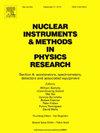Probabilistic modelling to account for uncertainty in portable energy dispersive X-ray diffraction measurements
IF 1.5
3区 物理与天体物理
Q3 INSTRUMENTS & INSTRUMENTATION
Nuclear Instruments & Methods in Physics Research Section A-accelerators Spectrometers Detectors and Associated Equipment
Pub Date : 2025-03-21
DOI:10.1016/j.nima.2025.170430
引用次数: 0
Abstract
Security systems often rely on being able to identify unknown materials in order to categorise them as harmful or safe. The process must be non-destructive, to preserve the material, and be applicable at a distance to reduce the hazard posed when performing the analysis. These restrictions have led to the use of X-ray diffraction imaging, with the challenge then becoming how best to analyse the data to provide well calibrated risk estimates. In this work, we explore probabilistic methods for quantifying our uncertainty when classifying energy dispersive X-ray diffraction data. Changes in the observational environment, or in the condition of the material itself, will introduce significant variation in the data collected. Through the use of a novel detector system, we collect data which aims to represent some of this uncertainty whilst capturing both angular and energy information. We apply Bayesian modelling techniques to the resultant images to enable inference of material properties whilst being robust to changes in experimental geometry. Such a model is more robust to operating in differing environments, and therefore well suited to practical applications. This model additionally aims to provide well quantified probabilities, in contrast to other approaches which do not assign a confidence level, allowing for more informed decision making. Our probabilistic approach is particularly well suited to a small data domain, where collecting data is a costly exercise and incorporating prior knowledge is desirable. We find that our model manages to extract key, material-specific information such that it is able to classify them with approximately 70% accuracy. Finally, we begin to develop an explicit Bayesian model of the experimental design, opening the way for future work to increasingly parameterise the data collection process and more accurately quantify uncertainty, and to do so across more varied environments.
求助全文
约1分钟内获得全文
求助全文
来源期刊
CiteScore
3.20
自引率
21.40%
发文量
787
审稿时长
1 months
期刊介绍:
Section A of Nuclear Instruments and Methods in Physics Research publishes papers on design, manufacturing and performance of scientific instruments with an emphasis on large scale facilities. This includes the development of particle accelerators, ion sources, beam transport systems and target arrangements as well as the use of secondary phenomena such as synchrotron radiation and free electron lasers. It also includes all types of instrumentation for the detection and spectrometry of radiations from high energy processes and nuclear decays, as well as instrumentation for experiments at nuclear reactors. Specialized electronics for nuclear and other types of spectrometry as well as computerization of measurements and control systems in this area also find their place in the A section.
Theoretical as well as experimental papers are accepted.

 求助内容:
求助内容: 应助结果提醒方式:
应助结果提醒方式:


